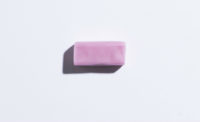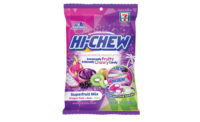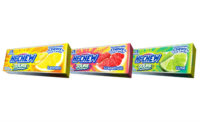Over the last decade, Morinaga America has strived to carve out a place in the U.S. confectionery market for its fruity, chewy HI-CHEW brand.
But where exactly it fits within the market is not easy to describe. HI-CHEW certainly isn’t gummy candy, but it’s not chewing gum or taffy, either. It offers a longer chew than most gummies, but it doesn’t stick to teeth like taffies and fruit chews.
HI-CHEW’s unique, hard-to-pin-down texture, combined with Morinaga America’s commitment to flavor innovation and building brand awareness, has captured candy lovers’ attention since its introduction in the United States in 2008. Growth in demand prompted the construction of a HI-CHEW manufacturing facility in North Carolina in 2015, and since then, output has nearly doubled.
Though Morinaga America has experienced a strong 12 years, its eyes are on the future, with the goals of learning more about its core audience, refining its brand message and introducing one-of-a-kind products to engage fans and develop new ones.
Morinaga comes to the U.S.
Establishing a presence in the United States seems to have always been in the cards for Morinaga.
At age 23, the Japanese company’s founder, Taichiro Morinaga, moved to the United States in 1888 in search of his destiny. He tried a piece of marshmallow candy there, and it changed his life.
Morinaga vowed to learn the candy-making trade and bring marshmallow candy to Japan, returning to his home country in 1899. In 1956, Morinaga launched Chewlets, the predecessor to HI-CHEW. These strawberry-flavored, bite-sized pieces could be chewed like gum, but since they dissolved in the mouth, they didn’t need to be spit out or taken out by hand, which could be seen as rude.
HI-CHEW, as Japan and the world knows it, launched in 1975. It became popular among young people, but Japan’s population continues to age. To expand the brand, Morinaga had to look beyond Japan’s borders, said Kayleigh Westerfield, marketing manager, Morinaga America, Inc.
“Knowing how big our country is and how much candy we eat, they saw, with some preliminary research, there was an opportunity in the marketplace,” she said. “Fruity, chewy candy has been growing the last several years, but HI-CHEW is a very distinct product — there was really nothing else on the shelf that was like it.”
The company founded Morinaga America, Inc. in southern California in 2008 in Torrance, later moving 35 miles southeast to Irvine. In addition to making importing easier, the West Coast offered access to an Asian population already connected with HI-CHEW.
“The Asian influence was huge at the beginning — trying to leverage off of people who recognized the brand and knew Morinaga as a company,” Westerfield said.
Growing beyond the Asian market was slow going at first. Westerfield recalled sales representatives going door-to-door to individual 7-Eleven locations asking if owners would consider taking a free HI-CHEW counter display, just to see how it would sell.
That’s markedly different from the company’s relationship with 7-Eleven in 2019. HI-CHEW launched its Superfruit Mix exclusively with the convenience chain in February before expanding distribution.
“Our company is so appreciative that we’re able to launch HI-CHEW products nationally to retail partners such as 7-Eleven,” Westerfield said. “It just shows how far the company has come in the last several years.”
Building in North Carolina
As the HI-CHEW brand expanded into convenience, grocery, drug and mass retail channels, it became clear Morinaga America would need to make more candy. Shipping it from overseas production facilities would no longer be enough — Morinaga realized they’d need to build a manufacturing facility in the U.S.
In 2012, the company began planning to build a roughly 100,000-sq.-ft. manufacturing facility on a 21-acre site on the edge of Mebane, N.C., about 25 miles northwest of Durham.
“HI-CHEW was so well-received, they knew if they really wanted to make a push to be able to strongly market it here, we wouldn’t be able to supply the demand from our current overseas operations,” said Lindsay Efland, general manager — engineering, Morinaga America Foods. “They wanted to get established here — not only to establish that brand but to establish our ability to service that need.”
Morinaga America Foods (MAF), the company’s U.S. manufacturing division, broke ground on the facility in May 2014, ultimately investing $32 million in the project. Nichole Oster, MAF general manager — production, noted the Mebane site offered plenty of advantages.
“With the downfall of the textile industry, we ended up having a talented labor force that was being underutilized, especially in this area,” she said. “Add in being close to the port, being right on the I-40 corridor, it’s the perfect mix. In addition, we were able to get a lot of good incentives from the state, Orange county and City of Mebane.”
When production came online in 2015, MAF began making HI-CHEW in five core flavors: Strawberry, Green Apple, Grape, Mango and Cherry. Overall capacity has since doubled.
Production also began with one shift of 35 employees, but now MAF has 144 employees working three shifts Monday through Friday, Oster said.
But MAF hasn’t just expanded its capacity and labor force. This year, the company will begin making Fruit Combos, a product that leverages HI-CHEW’s signature dual layers and the overall trend of flavor mashups. The Tropical Smoothie variety features a mango center and a passionfruit exterior layer, while the Piña Colada variety will feature a pineapple center and a coconut exterior layer.
Efland noted MAF will install additional equipment this year to meet increased demand and to accommodate manufacturing Fruit Combos and other new items. The addition will also require deft juggling of production schedules, he added.
“It’s going to add some intricacy that will be challenging but will also be fun,” Efland said. “We’ll keep the employees excited about producing something new.”
While it won’t be produced in North Carolina, Morinaga America, Inc. has another HI-CHEW product on tap for 2020 sure to bubble over with flavor. The Soda Pop Mix bag will feature a Cola variety and a piece inspired by Ramune, a Japanese carbonated beverage. The lemon-lime soft drink is known for being packaged in glass bottles that require the drinker to press a glass marble into their tops.
“I think it’s going to be a win for us,” Westerfield said. “Japanese influence and Asian influence is so trendy right now, so bringing in Ramune and trying to introduce it to the larger American audience is going to be really interesting.”
The Soda Pop Mix joins a peg bag lineup that includes the Original Mix, featuring Strawberry, Green Apple and Grape; the Sweet & Sour Mix, featuring Watermelon, Grapefruit and Lemon flavors; the Superfruit Mix, featuring Dragon Fruit, Acai and Kiwi; the Strawberry Bag, featuring Strawberry only; and the Tropical Mix, including Mango, Kiwi and Pineapple.
Building a consumer base
Crafting candy is only part of the equation. Over the last five years, Morinaga America, Inc. has worked to better understand the HI-CHEW customer and develop packaging that draws them to the product.
Westerfield said the company has learned U.S. consumers have a different palate than Japanese consumers, which makes a difference when it comes to choosing flavors to bring over from Japan.
“We like more intense flavor in our candy. That has played a lot into it,” she said. “Taking advantage of the growth of the (chewy) category is great, too, but a lot of the flavors we offer are really unique compared to the competition. Not a lot of people have an Açaí or a Dragon Fruit. That really sets us apart.”
The HI-CHEW team brought Dragon Fruit to the U.S. because of the brand’s consumers. It was named the winner of HI-CHEW’s East Meets West Flavor Vote campaign, held in March and April 2018. Voters had the chance to choose from 20 flavors, including Asian Pear, Banana Fizz, Lychee and Chocolate Banana.
Coincidentally, Starbucks launched its Mango Dragon fruit Refresher three months later.
“Trying to find trend information can be difficult,” Westerfield said. “You’re trying to do the research ahead of time, and you don’t know if it’s going to be hit or miss. Asking people what they want, how they want it — that’s really important.”
HI-CHEW launched Dragon Fruit in February 2019 with the Superfruit Mix, which also features Açaí and Kiwi. All include chia seeds for added texture. So far, it’s performing well.
“That reinforced the validation of ‘let’s put it out there, see what American consumers want and see if, in turn, they actually buy it, and it worked,” Westerfield said.
Morinaga America has boosted efforts to study its consumers, gathering data through social media and other forms of consumer research. The company has learned it’s targeting a dual audience — children who want chewy candy and unique flavors and parents who may appreciate the candy’s natural colors and flavors, non-GMO ingredients and individually-wrapped pieces.
“You’re still making it cool and trendy for the kids, where they’ll want to share it with their friends, but you have that permissibility conversation with Mom to say ‘this is a better-for-you candy option,” Westerfield said.
She added there is opportunity with Generation X and Baby Boomers, who buy chewy candy for the children in their lives but may also enjoy it, too.
“With the quality of the candy and the unique flavors, it sets us up for maybe a slightly older target,” Westerfield said. “We hear that kids love it — they’re the ones setting the trends. Mom or Dad tries it and says ‘this is really great,’ and Mom and Dad eat it, too.”
Communicating these messages, along with the essence of what HI-CHEW is, has involved revamping HI-CHEW packaging. In 2017, Morinaga America redesigned its standup and peg bags with a geometric pattern to capture the fun essence of the brand and product imagery for customers to better understand HI-CHEW’s dual layers. The brand also added a transparent window to show off the individually-wrapped pieces.
Westerfield said the packaging retained the retro HI-CHEW logo and the real fruit imagery. Merchandising the product correctly was also key, she added.
“The way it was merchandised in store was a little bit confusing because sometimes, especially in the Asian aisle, it’s positioned next to soy sauce (and) rice noodles, so I think people were confused in the beginning about what the product was until after they purchased it,” she said.
Last year, Morinaga America updated its stick packaging. It also reworked its convenience counter trays to give them more height as well as a fold-over component to provide more information about the product.
“I have no doubt the stick sales are going to increase for us based on the design updates,” Westerfield said.
While preliminary research is underway to determine which Morinaga brand the company might want to bring to the U.S. next, its main focus is continuing to strengthen the HI-CHEW brand.
“There’s an opportunity for us to continue to build off the HI-CHEW name in other pack types and flavors,” she said. “There’s a lot of room left for HI-CHEW.”












